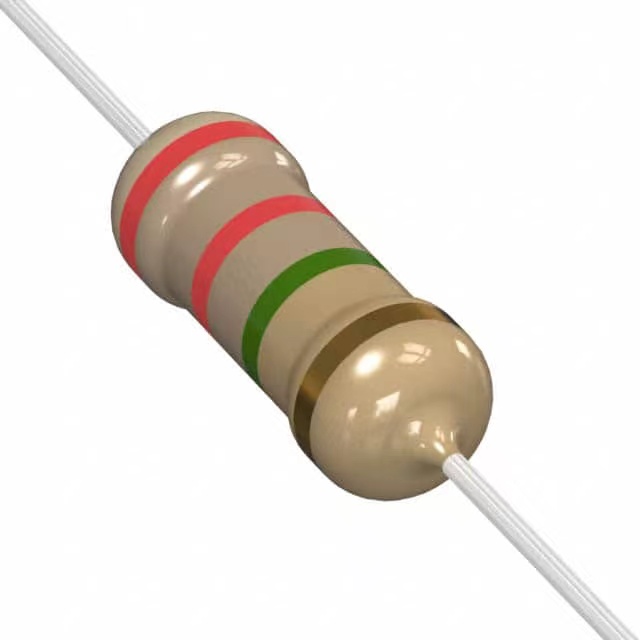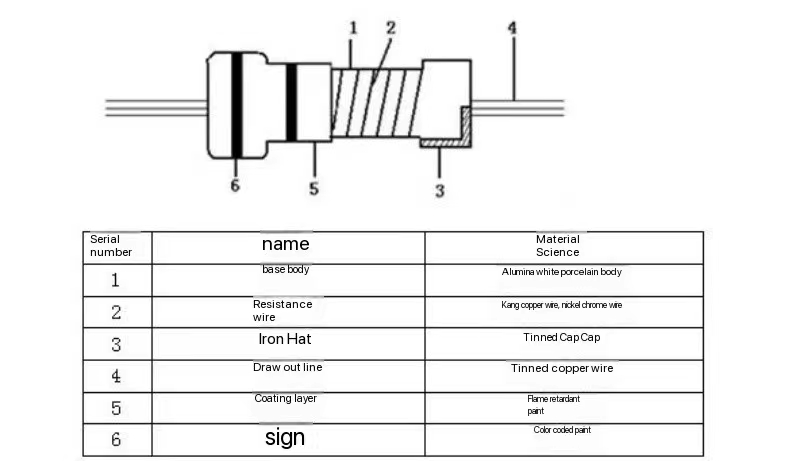What is a through-hole resistor?

What is a through-hole resistor?
Through-hole resistance is a common name for through-hole resistance by some engineers, which means the resistance of the intermediate through-hole. Through the hole in the middle, inserting a metal rod is easy to install. The outer layer is a layer of metal film or carbon film, and the through-hole in the middle of the color ring resistance, which refers to the through-hole resistance. It is a passive electronic component that is connected to the circuit through two pins to limit the magnitude of the current through the branch through which it is connected.

What are through-hole resistors made of?
The performance and reliability of the through-hole resistor depend on the manufacturing process and the selected material:
Resistance materials: Common resistance materials include carbon film, metal film, film and metal foil. Different materials have different temperature coefficients, accuracy and power processing capacity.
Manufacturing process: The manufacture of through-hole resistors usually includes printing, evaporation, cutting and testing and other processes. The manufacturing process of high-precision resistors is more complicated.
Packaging: Through-hole resistors usually need to be packaged and packaged to protect resistance elements from environmental influences, such as moisture, corrosion and mechanical damage.
What is the use of through-hole resistor?
Through-hole resistance plays an important role in electronic engineering. It is mainly used to control the current and voltage in the circuit, prevent circuit damage, and prevent signals from being interfered by the outside world.
Through-hole resistance has many different functions, including but not limited to circuit current limitation, power supply voltage stabilization, noise suppression, circuit protection, etc. These applications make through-hole resistors an indispensable component in electronic engineering.
1. Current limit: In the circuit, the through-hole resistor can be used to limit the current. If a through-hole resistor is added to the circuit, the current in the circuit can be limited, thus avoiding circuit complications.
2. Resistance voltage division: Through-hole resistors are often used in voltage division circuits. In the voltage division circuit, the two resistors are connected in series, and the output voltage is the voltage division between the two resistors on the circuit. For example, through-hole resistors can be used in sound or audio attenuators.
3. Voltage regulator: Sometimes, through-hole resistors are used as voltage regulators in power supply circuits. If the normal output voltage exceeds the set value, the through-hole resistance will play a role in limiting the current.
What are the main classifications of through-hole resistors?
Carbon film resistance: Carbon film resistance is to decompose hydrocarbons in high temperature and vacuum and precipitate on porcelain rods or porcelain tubes to form a layer of crystalline carbon film. The cost of this kind of resistance is low, but the stability is poor and the error is large. It is suitable for circuit occasions with low requirements.
Metal film resistance: The metal film resistance is to heat the alloy in a vacuum to evaporate and form a conductive metal film on the surface of the porcelain rod. This kind of resistance has a wide range of resistance, which can be made into high-precision resistance, with low noise and low temperature coefficient, which is suitable for occasions with high accuracy requirements.
Metal oxide film resistance: Metal oxide film resistance is formed by spraying metal salt solutions such as tin and antimony onto the surface of the hot ceramic skeleton and deposited by hydrolysis. This kind of resistance has good oxidation resistance and thermal stability, which is suitable for non-combustible, temperature-resistant, moisture-resistant and other occasions.
Wire winding resistance: The wire winding resistance is made of nickel-chromium alloy wire wound on a ceramic tube covered with organic glass coating. This kind of resistance is accurate, stable and has a small temperature coefficient. It is suitable for low-frequency circuits with high accuracy requirements.
High-power wire-wound resistors: High-power wire-wound resistors are coiled on certain objects, such as ceramic tubes, ceramic rods, etc., and are designed to be installed on metal plates or bases to better conduct heat. This kind of resistance is suitable for high-power occasions, and the rated power is generally more than 1W.
Zero ohm resistor: The zero ohm resistor looks like a diode coated with a black channel in the center, which is suitable as a simple wire connection when wiring PCB board. It has the advantages of convenient mechanized installation and low crossover capacitors.
Fuse resistor: When the circuit fails, when the power exceeds the rated power, it will melt like a fuse, disconnect the circuit, and play a protective role. This kind of resistance is suitable for constant voltage circuits, battery chargers, TVs and other circuits.
Sensitive resistance: Sensitive resistance refers to a resistor whose resistance value is sensitive to a certain physical quantity (such as temperature, humidity, light, etc.).

According to the sensitivity to different physical quantities, sensitive resistors can be divided into heat-sensitive, moisture-sensitive, light-sensitive, pressure-sensitive, force-sensitive, magnetic-sensitive and gas-sensitive.
What is the difference between SMD and through-hole resistor?
The main differences between SMD and through-hole resistors are volume, weight, stability, reliability, heat dissipation ability, welding and disassembly difficulty, and application scenarios.
The volume and weight of SMD are only about 1/10 of the through-hole resistance. The commonly used packaging size of SMD is 0805 or 220, while the size of through-hole resistance is usually larger, such as 1206.
SMD is small in size and light in weight, which is convenient for storage and transportation. In contrast, the through-hole resistor is large in volume, heavy in weight and uses a lot of materials.
SMD has high stability and reliability, which is suitable for small electronic products. The through-hole resistor has high stability and reliability, which is suitable for high-power products.
The through-hole resistor can withstand a large current, its performance is more stable, and it is suitable for use in harsh environments.
Through-hole resistor Due to its large volume and good heat dissipation ability, it is suitable for use in high-power products.
SMD is suitable for use in low-power products due to its small size and poor heat dissipation ability.
SMD is relatively easy to weld and disassemble. There is no need for through-hole welding, and the amount of tin is small, which is suitable for automated production.
It is relatively difficult to weld and disassemble through-hole resistors, especially multi-pin components, which are easy to damage the circuit board.
SMD is suitable for small electronic products, such as mobile phones, tablets, etc., because of its small size, light weight and easy to automate production.
Through-hole resistors are suitable for high-power products, such as power supplies, motor controllers, etc., because of their strong heat dissipation ability, high stability and reliability.
What is the power rating of a through-hole resistor?
The power calculation formula of the through-hole resistor is: P=I²R, where P is the power (unit: watt), I is the size of the current passing through the resistance in the circuit (unit: ampere), and R is the resistance value (unit: ohm).
Therefore, the power of the through-hole resistor depends on the resistance value and current size. When the resistance value is determined, the power increases with the increase of the current size; when the current size is determined, the power increases with the increase of the resistance value.
What are the markings on a through hole resistor?
The basic parameters and color rings are usually printed on the through-hole resistor, of which the color ring is used to indicate the resistance value. Under normal circumstances, the side near a red ring on the resistor is the positive pole, while the side close to a black ring is the negative pole.
What are common through-hole resistor sizes?
The size of the through-hole resistance is usually given in the form of length × diameter, in millimeters (mm). Common through-hole resistor packaging sizes include 2.5mm, 3.2mm, 5mm, 7.5mm and other different sizes, as well as standard packaging forms based on AXIALxx. The specific size should be determined according to the actual needs and circuit design, while considering the resistance, power, accuracy and other parameters of the resistance.In which fields can through-hole resistors be applied to?
1. Electric toolsThrough-hole resistors can be used as components such as temperature sensors, electronic controllers and overcurrent protectors in power tools.
Using through-hole resistors in the lighting system can reduce current fluctuations and improve the life of the bulb.
Through-hole resistors can be used for power distribution and signal conversion in electronic products. Electronic products such as TVs, mobile phones, computers, etc. use through-hole resistors to control the performance of the circuit, such as adjusting the volume, brightness, current, etc.
Through-hole resistors are widely used in automotive electronics, which can be used in in-vehicle entertainment systems, engine controllers and light controllers.
Through-hole resistors in wireless communication equipment, antennas and communication base stations are used for signal adjustment and matching.
The through-hole resistor in the power supply unit is used for voltage stabilization and current protection.
Through-hole resistors are used in the industrial control system to adjust the performance of sensors and actuators.
The through-hole resistors in medical instruments and equipment are used to monitor and control vital signs.
Do resistors lose resistance over time?
Ideally, the resistance value of the resistor is fixed and will not lose the resistance due to use. However, in practical applications, the resistance value of the resistor may change due to aging, temperature change and other factors. For example, the temperature coefficient of the resistor represents the percentage of the change of the resistance value every time the temperature rises by 1℃, which indicates the effect of temperature on the resistor.
Factors affecting the resistance of the resistor
The size of the resistance of the resistor is generally related to the temperature, material, length and cross-sectional area:Temperature: The increase in temperature will lead to an increase in the resistance value.
Material: Different materials have different resistivity, which affects the resistance value.
Length: The longer the length of the resistor, the greater the resistance value.
Cross-sectional area: The smaller the cross-sectional area, the greater the resistance value.
Statement
All articles (images, texts, audio) on this site are uploaded and shared by users, or integrated from relevant internet sources, only for user's learning. If your rights are violated, please contact the administrator to delete! Link to this article: https://www.jinftry.com







